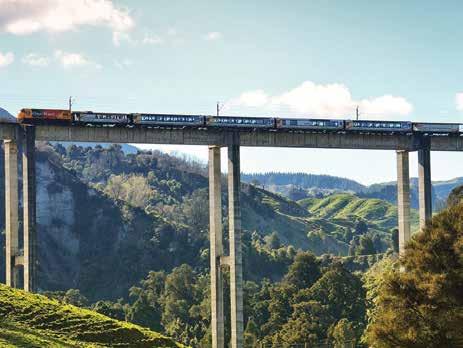
4 minute read
New Zealand
from REX Mar 2019
by Prime Group
KiwiRail continued its recovery from the Kaikoura earthquake, which struck in 2016.
KiwiRail revenue up 12pc
NEW ZEALAND’S NATIONAL RAIL operator KiwiRail has posted improved financials for the first half of FY19, with overall revenue up 12 per cent on the previous year.
KiwiRail chairman Greg Miller said on February 20 the company was making good progress shaking off the impacts of the 2016 Kaikoura earthquake, which inflicted substantial damage to infrastructure on the South Island’s Main North Line. “It will take some time to get back to where we were before the Main North Line was closed following the quake but we are seeing increased demand in this result,” Miller said.
Following the reopening of the Main North Line, KiwiRail reported 30 per cent growth in domestic freight revenue in the first half of FY19.
This was bolstered by 15 per cent growth in forestry revenue, 8 per cent growth in bulk freight revenue and 8 per cent growth in tourism revenue.
The state-owned operator reported an operating surplus of $16.3 million, up 7 per cent year-on-year for the first half.
“KiwiRail has overcome enormous challenges in the past two years and there are still increased cost pressures resulting from increased regulation, compliance and committing to future investments that will pay back in the long term,” Millersaid. “What this result highlights, however, is that we are ready to embrace growth and invest in our next phase of development.” Miller said getting more freight on rail would be crucial for the continued development of both KiwiRail and New Zealand as a whole.
“The more freight we get onto rail, the fewer trucks we have on New Zealand roads which increases safety for everyone, reduces carbon emissions and means less road maintenance for taxpayers.” Acting chief executive Todd Moyle agreed. “New Zealanders are increasingly seeing the benefits rail delivers in our cities, in growing regional economies and in making our roads safer,” Moyle said. “ It will take some time to get back to where we were before the Main North Line was closed following the quake but we are seeing increased demand ”
450 wagon purchase In the fortnight prior to announcing its financials, KiwiRail disclosed it had ordered 450 rail wagons from a Chinese manufacturer.
In a short statement on February 8, the operator detailed it had entered into a contract with CRRC Qiqihar Rolling Stock Co. for the construction of 450 flattop rail wagons.
The operator did not say how much the contract was worth, only that it was disclosing the purchase under the Crown’s SOE continuous disclosure rules for transactions of more than $50 million. It said delivery of the wagons is expected prior to the 2019 peak freightseason. In FY18 KiwiRail launched a strategy to deliver future rollingstock, citing “decades of underinvestment in its assets,” and noting “many of its trains and wagons are at the end of their useful lives”.
KiwiRail acquired 150 new wagons in FY18, and said in its annual integrated report it was targeting the acquisition of 235 heavy wagons in FY19.
www.railexpress.com.au The state-owned operator disclosed a 450-wagon purchase from a Chinese manufacturer in February.

First step towards Northport spur Meanwhile, the operator says the first stage of planning is complete for a 20-kilometre rail spur to Northport at Marsden Point.
Workers have spent the last three months drilling into hills, land and coastal areas north of Auckland to understand the challenges of building what would be the country’s first new significant branch line in over half a century.
Moyle visited Northport on January 31 to see workers completing the last drilling of the first stage of exploration works. He said stage two

SYDNEY METRO would begin later this year. “This is not an easy job but it is a real signal of the Government’s commitmentto boosting regional economies through rail,” he said. “Our investigations have focused on areas where the most significant engineeringworks would be needed.” The next planning stages include further work along the route to advance the design of the line and prepare for the next phases of the project.
“Concurrently we are looking at how we can upgrade the North Auckland Line between Auckland and Oakleigh,” Moyle continued. “The tunnels on that line are old, low and narrow. We have had two significant derailments on the line in recent months due to a lack of funding for maintenance. It has been unable to carry passengers for the past year and freight options are restricted. This is the result of low freight volumes on the line and KiwiRail needing to spend its limited capital where the most freight flows.”
Miller said an efficient supply chain would be critical for Northland to respond to significant agricultural and horticultural investment. “What we are seeing now through the Provincial Growth Fund is a renewal of regional rail and an acceptance of the wider benefits rail brings to regions such as taking trucks off the road, reducing road maintenance costs, improving road safety and producing fewer carbon emissions,” Miller said.
“There is a long way to go in Northland but we are heartened by whatwe have found so far.”
KiwiRail is a statutory corporation reporting to the New Zealand Government.









